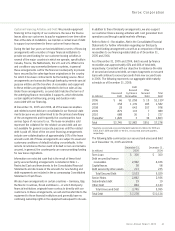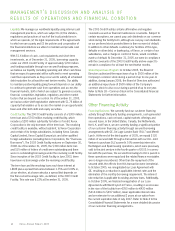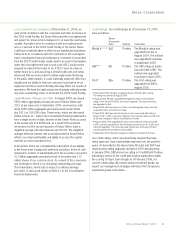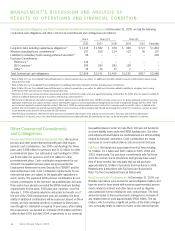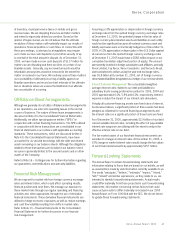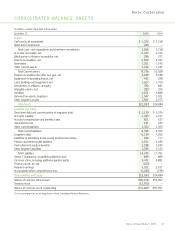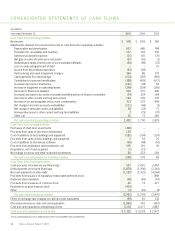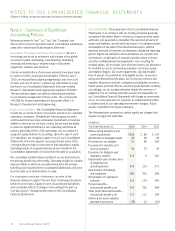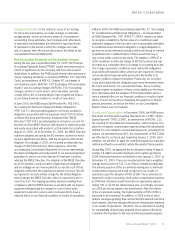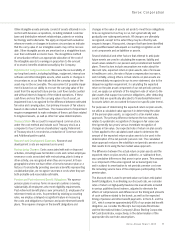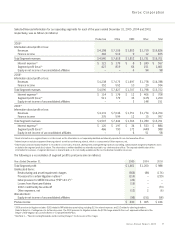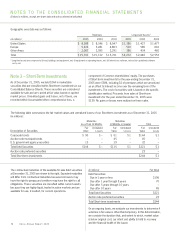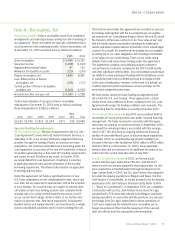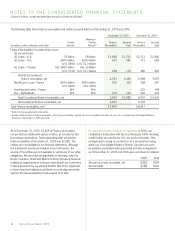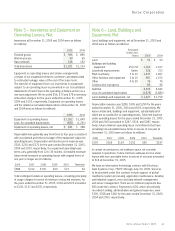Xerox 2005 Annual Report Download - page 59
Download and view the complete annual report
Please find page 59 of the 2005 Xerox annual report below. You can navigate through the pages in the report by either clicking on the pages listed below, or by using the keyword search tool below to find specific information within the annual report.
Xerox Corporation
51
Changes in Estimates: In the ordinary course of accounting
for items discussed above, we make changes in estimates
as appropriate, and as we become aware of circumstances
surrounding those estimates. Such changes and refinements
in estimation methodologies are reflected in reported results
of operations in the period in which the changes are made
and, if material, their effects are disclosed in the Notes to the
Consolidated Financial Statements.
New Accounting Standards and Accounting Changes:
During the two years ended December 31, 2005, the Financial
Accounting Standards Board (“FASB”) issued several pronounce-
ments of significance to the Company which are discussed in
detail below. In addition, the FASB issued several other pronounce-
ments, including standards on inventory (SFAS No. 151 “Inventory
Costs, an amendment of ARB 43, Chapter 4”), exchanges of
nonmonetary assets (SFAS No. 153 “Exchanges of Nonmonetary
Assets”) and accounting changes (SFAS No. 154 “Accounting
Changes and Error Corrections”), which we either currently
comply with or arenot anticipating to have a significant impact
on our future financial condition or results of operations.
In June 2005, the FASB issued Staff Position No. FAS 143-1,
“Accounting for Electronic Equipment Waste Obligations”
(“FSP 143-1”), which provided guidance on the accounting for
obligations associated with the European Union (“EU”) Directive
on Waste Electrical and Electronic Equipment (the “WEEE
Directive”). FSP 143-1 provided guidance on how to account for
the effects of the WEEE Directive with respect to historical waste
and waste associated with products on the market on or before
August 13, 2005. As of December 31, 2005, the WEEE Directive
had been adopted into law by the EU member countries in which
we have significant operations, with the exception of the United
Kingdom. Accordingly, in 2005, we recorded an initial after-tax
charge of $18 ($26 pre-tax) in Other expenses, net in the
accompanying Consolidated Statement of Income representing
the disposal obligation primarily related to our leased equipment
population in service as of the date the EU member countries
adopted the WEEE Directive. The adoption of the WEEE Directive
by an EU member country created a legal disposal obligation
and accordingly we are now required to accrue the cost of that
obligation at the time the equipment is placed in service. We will
be required to record a similar charge for the United Kingdom
when it adopts the WEEE Directive, which is expected to be no
more than $10. The ongoing quarterly expense resulting from
compliance with the WEEE Directive associated with our leased
equipment will generally be charged to cost of sales when
equipment is placed in service and is not expected to have a
material effect on our financial condition or results of operations.
In March 2005, the FASB issued Interpretation No. 47, “Accounting
for Conditional Asset Retirement Obligations – an interpretation
of FASB Statement No. 143” (“FIN 47”). FIN 47 requires an entity
to recognize a liability for the fair value of a conditional asset
retirement obligation if the fair value can be reasonably estimated.
Aconditional asset retirement obligation is a legal obligation to
perform an asset retirement activity in which the timing or method
of settlement are conditional upon a future event that may or
may not be within control of the entity. The adoption of FIN 47 in
2005 resulted in an after-tax charge of $8 ($12 pre-tax) and was
recorded as a cumulative effect of change in accounting principle.
This charge represents conditional asset retirement obligations
associated with leased facilities where we are required to remove
certain leasehold improvements and restore the facility to its
original condition at lease termination. Previously, we recorded
costs associated with this obligation upon lease termination when
the costs were known. On a prospective basis, this accounting
change requires recognition of these costs ratably over the lease
term. We believe that the adoption of this interpretation will not
have a material effect on our financial condition or results of oper-
ations. The pro forma effect of applying this guidance in all prior
periods presented, as well as the effect on our Consolidated
Balance Sheet, was not material.
Stock-Based Compensation: In December 2004, the FASB issued
Statement of Financial Accounting Standards No. 123(R), “Share-
Based Payment” (“FAS 123(R)”), an amendment of FAS No. 123,
“Accounting for Stock-Based Compensation,” which requires com-
panies to recognize compensation expense using a fair-value-based
method for costs related to share-based payments, including stock
options. As permitted by the SEC, the requirements of FAS 123(R)
areeffective for our fiscal year beginning January 1, 2006. Upon
adoption, we will elect to apply the modified prospective transition
method and therefore we will not restate the results of prior periods.
During May 2005, we approved the accelerated vesting of approx-
imately 3.6 million unvested employee stock options granted in
2004, that would have been scheduled to vest January 1, 2007, to
December 31, 2005. These accelerated options had a weighted
average exercise price of $13.71 as of the accelerated vesting date.
The primary purpose of this accelerated vesting was to eliminate
compensation expense we would recognize in our results of
operations upon the adoption of FAS 123(R). The acceleration is
expected to reduce our pre-tax stock option compensation expense
in 2006 that otherwise would have been recognized by approxi-
mately $31 or $0.02 per diluted share and, accordingly, increase
our 2005 pro forma expense disclosed below. After the effects
of the accelerated vesting, the implementation of FAS 123(R) is
expected to be immaterial. In addition, in 2005 in lieu of stock
options, we began granting time- and performance-based restricted
stock awards, which are already reflected as compensation expense
in our results of operations. Therefore, the acceleration of vesting
for substantially all previously awarded stock options effectively
completes the transition to the new stock-based award program.
Xerox Annual Report 2005


